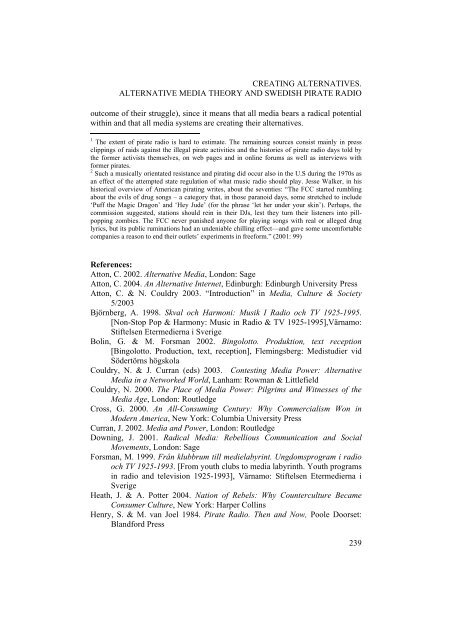culture, subculture and counterculture - Facultatea de Litere
culture, subculture and counterculture - Facultatea de Litere
culture, subculture and counterculture - Facultatea de Litere
You also want an ePaper? Increase the reach of your titles
YUMPU automatically turns print PDFs into web optimized ePapers that Google loves.
CREATING ALTERNATIVES.<br />
ALTERNATIVE MEDIA THEORY AND SWEDISH PIRATE RADIO<br />
outcome of their struggle), since it means that all media bears a radical potential<br />
within <strong>and</strong> that all media systems are creating their alternatives.<br />
1 The extent of pirate radio is hard to estimate. The remaining sources consist mainly in press<br />
clippings of raids against the illegal pirate activities <strong>and</strong> the histories of pirate radio days told by<br />
the former activists themselves, on web pages <strong>and</strong> in online forums as well as interviews with<br />
former pirates.<br />
2 Such a musically orientated resistance <strong>and</strong> pirating did occur also in the U.S during the 1970s as<br />
an effect of the attempted state regulation of what music radio should play. Jesse Walker, in his<br />
historical overview of American pirating writes, about the seventies: “The FCC started rumbling<br />
about the evils of drug songs – a category that, in those paranoid days, some stretched to inclu<strong>de</strong><br />
‘Puff the Magic Dragon’ <strong>and</strong> ‘Hey Ju<strong>de</strong>’ (for the phrase ‘let her un<strong>de</strong>r your skin’). Perhaps, the<br />
commission suggested, stations should rein in their DJs, lest they turn their listeners into pillpopping<br />
zombies. The FCC never punished anyone for playing songs with real or alleged drug<br />
lyrics, but its public ruminations had an un<strong>de</strong>niable chilling effect—<strong>and</strong> gave some uncomfortable<br />
companies a reason to end their outlets’ experiments in freeform.” (2001: 99)<br />
References:<br />
Atton, C. 2002. Alternative Media, London: Sage<br />
Atton, C. 2004. An Alternative Internet, Edinburgh: Edinburgh University Press<br />
Atton, C. & N. Couldry 2003. “Introduction” in Media, Culture & Society<br />
5/2003<br />
Björnberg, A. 1998. Skval och Harmoni: Musik I Radio och TV 1925-1995.<br />
[Non-Stop Pop & Harmony: Music in Radio & TV 1925-1995],Värnamo:<br />
Stiftelsen Etermedierna i Sverige<br />
Bolin, G. & M. Forsman 2002. Bingolotto. Produktion, text reception<br />
[Bingolotto. Production, text, reception], Flemingsberg: Medistudier vid<br />
Sö<strong>de</strong>rtörns högskola<br />
Couldry, N. & J. Curran (eds) 2003. Contesting Media Power: Alternative<br />
Media in a Networked World, Lanham: Rowman & Littlefield<br />
Couldry, N. 2000. The Place of Media Power: Pilgrims <strong>and</strong> Witnesses of the<br />
Media Age, London: Routledge<br />
Cross, G. 2000. An All-Consuming Century: Why Commercialism Won in<br />
Mo<strong>de</strong>rn America, New York: Columbia University Press<br />
Curran, J. 2002. Media <strong>and</strong> Power, London: Routledge<br />
Downing, J. 2001. Radical Media: Rebellious Communication <strong>and</strong> Social<br />
Movements, London: Sage<br />
Forsman, M. 1999. Från klubbrum till medielabyrint. Ungdomsprogram i radio<br />
och TV 1925-1993. [From youth clubs to media labyrinth. Youth programs<br />
in radio <strong>and</strong> television 1925-1993], Värnamo: Stiftelsen Etermedierna i<br />
Sverige<br />
Heath, J. & A. Potter 2004. Nation of Rebels: Why Counter<strong>culture</strong> Became<br />
Consumer Culture, New York: Harper Collins<br />
Henry, S. & M. van Joel 1984. Pirate Radio. Then <strong>and</strong> Now, Poole Doorset:<br />
Bl<strong>and</strong>ford Press<br />
239












